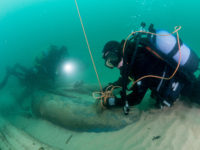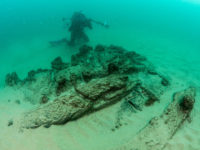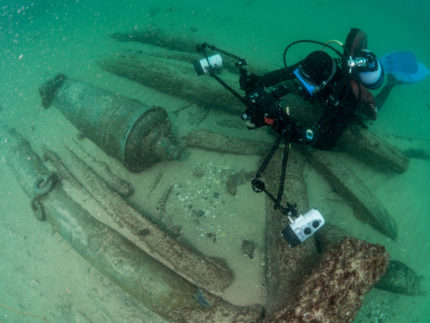 Archaeologists have discovered a 400-year-old shipwreck off the coast of the port town of Cascais 15 miles west of Lisbon, Portugal, whose cargo attests to the thriving trade between Portugal and India in the 16th and 17th centuries. The find was made as part of a decade-long project funded by the town of Cascais, the Portuguese government and navy, and Nova University in Lisbon to explore the mouth of the Tagus river, an epicenter for wrecks from the heyday of Portugal’s spice trade with Asia.
Archaeologists have discovered a 400-year-old shipwreck off the coast of the port town of Cascais 15 miles west of Lisbon, Portugal, whose cargo attests to the thriving trade between Portugal and India in the 16th and 17th centuries. The find was made as part of a decade-long project funded by the town of Cascais, the Portuguese government and navy, and Nova University in Lisbon to explore the mouth of the Tagus river, an epicenter for wrecks from the heyday of Portugal’s spice trade with Asia.
 The ship sank between 1575 and 1625 on the voyage back from India. It was found on September 4th 40 feet below the surface; the depth helped preserve the ship and its contents unusually well for the warm Portuguese coastal waters. Divers discovered nine bronze cannons bearing the Portuguese coat of arms, Chinese ceramics from the Wanli period (1573-1619), peppercorns and cowrie shells which were used as currency in the slave trade.
The ship sank between 1575 and 1625 on the voyage back from India. It was found on September 4th 40 feet below the surface; the depth helped preserve the ship and its contents unusually well for the warm Portuguese coastal waters. Divers discovered nine bronze cannons bearing the Portuguese coat of arms, Chinese ceramics from the Wanli period (1573-1619), peppercorns and cowrie shells which were used as currency in the slave trade.
The mayor of Cascais, Carlos Carreiras, described the discovery as one of the most significant archaeological finds of the past decade. He said that although the cargo ship had yet to be identified, it could prove significant to the town.
“It’s an extraordinary discovery that allows us to know more about our history, reinforcing our collective identity and shared values,” said Carreiras. “That, in turn, will certainly make us more attractive and competitive.”
The discovery comes 24 years after experts found the wreck of the Nossa Senhora dos Mártires (Our Lady of the Martyrs), which also sailed the spice route and sank off Lisbon in 1606.
According to the survey team, who have been mapping the areas since 2009, the latest wreck is in better structural shape than the Nossa Senhora dos Mártires.
This Reuters TV story has wonderful film of divers exploring the wreck. The visibility is excellent so you can get a close look at the remains of ship and its contents. Also heads up for the outstanding photo bomb from an indignant cephalopod at the 27 second mark.
